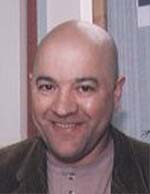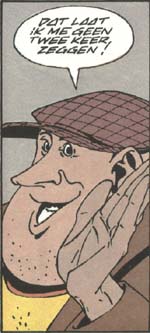Andreas: After
Révélations posthumes I had prepared a new project for
(A Suivre).
It was a rather long story of 120 pages. They refused it at
(A Suivre).
I didn't continue it then. It was a somewhat fantastic story,
something better suited for
Tintin/Hello BD (fr); Kuifje (nl).
So they were quite right for not wanting it. In the meanwhile I had
left
Tintin/Hello BD (fr); Kuifje (nl) and was suddenly out of work.
Luckily my friend
Antonio Cossu was in charge of a new series of
black-and-white comics at
Deligne (Michel). Then I said to him:
"I want to do something for you." I knew Deligne,
because he had published one of my stories from my time at Saint-Luc,
four plates based on a story by Jean Ray. Deligne was interested in my offer
and paid me - for that time - extremely well. He paid more than Tintin.
During the making of Cromwell Stone I moved to Brittany.
I wrote it in Paris, I drew it in Bretagne.

